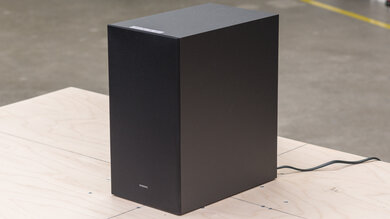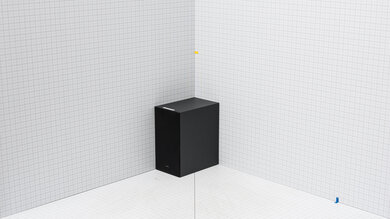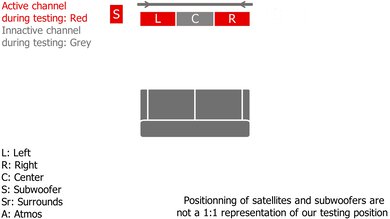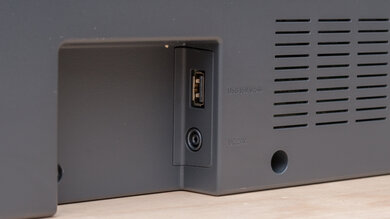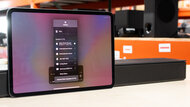The Samsung HW-Q60C/Q6CC is a 3.1 soundbar released in 2023. It's a simpler mid-range offering that brings some of the manufacturer's signature sound enhancement tools, including a 7-band graphic EQ to switch up its sound. Satellites aren't sold with this setup, which is great if you're low on space. However, you may want to add them for an improved surround sound.
Our Verdict
The Samsung HW-Q60C is good for mixed usage. It's a simple bar with a good sound suitable for many different types of audio content, especially more dialogue-focused TV shows and podcasts. Voices and clear and easy to follow, and it reproduces instruments with detail in your favorite songs, too. While it supports many different audio formats, it has to downmix more immersive formats into stereo sound, which doesn't sound as clear or real as more premium setups.
- Graphic EQ and presets.
- Gets loud.
- Bluetooth compatible.
- Lacks some low-bass.
- Downmixes height and surround sound.
The Samsung HW-Q60C is great for dialogue-centric TV shows and podcasts. This 3.1 setup has a discrete center channel designed to improve vocal reproduction in the mix. With a clear and detailed sound, it's easy to follow conversations on screen. The Adaptive Sound preset doubles as a dialogue enhancer, which is a nice touch.
- Graphic EQ and presets.
- Gets loud.
- Bluetooth compatible.
- No room correction.
The Samsung HW-Q60C is good for music. Out-of-the-box, you get good sound, especially compared to other bars in its price range. Voices and lead instruments are clear and detailed in the mix, and there are many different customization tools to get the sound you want. The sub is pretty one-note, though, and you don't get a lot of thump and rumble with more bass-heavy tracks like EDM and hip-hop.
- Graphic EQ and presets.
- Gets loud.
- Lacks some low-bass.
The Samsung HW-Q60C is decent for movies. It supports many audio formats commonly found on streaming platforms and Blu-rays, like Dolby Digital and Dolby Atmos. As a 3.1 setup, it has to downmix this content into stereo to play it back. The resulting sound isn't quite as immersive as with more premium setups. Dialogue remains clear in the mix, so it's easy to follow along.
- Graphic EQ and presets.
- Gets loud.
- Lacks some low-bass.
- Downmixes height and surround sound.
Changelog
- Updated Sep 24, 2024: Updated the Stereo Dynamics results with new methodology from Test Bench 1.3. Added text to the Audio Latency: ARC, Audio Latency: HDMI In, and Audio Latency: Optical boxes.
- Updated Sep 19, 2024: We've converted this review to Test Bench Update 1.3. If applicable, we've retested stereo sound based on the manufacturer's recommendations. Additionally, we've expanded our audio latency tests to the following boxes: Audio Latency: ARC, Audio Latency: HDMI In, and Audio Latency: Optical. You can see the full changelog here.
- Updated Dec 19, 2023: Added market comparison with the Samsung HW-Q600C/Q60CC in the Height (Atmos) box.
- Updated Dec 04, 2023: Added a mention of the Samsung HW-QCC variant in the Variants box.
Check Price
Differences Between Sizes And Variants
The Samsung HW-Q60C is available in Black. It's also available as the Samsung HW-Q6CC. The label for the model we tested is here.
Let us know in the forums if you encounter another version of this soundbar.
Compared To Other Soundbars
The Samsung Q6CC soundbar is the next generation of the Samsung HW-Q60B. Their performances are similar, though the Q60C offers a few improvements, especially with its low-frequency extension. As a simple mid-range offering, it's mostly designed for listening to stereo content like music and TV shows. It doesn't bring as many features as some of the manufacturer's more premium bars, like room correction, and you'll have to purchase its satellites separately if you want an improved surround sound.
You can also check out our recommendations for the best soundbars under $300, the best Samsung soundbars, and the best soundbars with a subwoofer.
The Samsung HW-Q600C/Q60CC is better than the Samsung HW-Q60C/Q6CC, especially for height content like Dolby Atmos. The Q600C has two up-firing channels, so it doesn't have to downmix Atmos content into stereo like the Q60C. The resulting sound is more clear and life-like. The Q600C has a better stereo soundstage, too.
The Samsung HW-Q60C/Q6CC is the next generation of the Samsung HW-Q60B. Both bars have similar designs and similar overall performances regarding their sound. However, the Q60C offers a few improvements, notably with low-frequency extension.
The Samsung HW-Q60C/Q6CC is a more versatile soundbar than the Samsung HW-B650. They're both 3.1 setups, but the Q60C supports more audio formats. For example, it supports Dolby Atmos, Dolby Digital Plus, and Dolby TrueHD. It's not "true" support since it has to downmix these formats into stereo, but it's better than nothing.
The main appeal of the Samsung HW-Q60C/Q6CC over the Samsung HW-B750D is its ability to playback a greater selection of audio formats. However, the HW-Q60C/Q6CC can't actually provide the dimension of height that's expected from Dolby Atmos content because the bar lacks up-firing drivers, and it necessarily downmixes multi-channel formats to stereo anyhow because it's a 3.1 design. Neither soundbar has an app, but their remotes provide a graphic EQ, so you can tweak either for a different sound. The side-firing drivers on the 5.1 HW-750D lend it a better stereo soundstage and a more immersive surround sound experience, but it's still limited to Dolby Digital, DTS, and PCM audio formats.
Test Results

The Samsung Q60C soundbar has a similar appearance to its predecessor, the Samsung HW-Q60B. Metal grilles cover most of the bar, while the back and bottom are plastic. The angled end caps are made of plastic, too.
The sub resembles the model that comes with the Samsung HW-Q60B. It's mostly made of vinyl-wrapped wood with a plastic back. The front is covered in fabric. You find the port and the pairing button on the back, too.
You can add on satellites sold separately by the manufacturer if you want.
The Samsung Q60C soundbar has great build quality. The bar itself feels solid and sturdy, with metal grilles to help protect the drivers inside. The plastic feels of good quality, too. The sub also seems pretty solid, though the fabric wrapping in front is quite thin. It doesn't seem to offer much protection to the driver inside. Plus, it could gather dust and hair over time.
This bar has a great stereo frequency response. Given its price, it offers good sound, with a pretty clear and accurate reproduction of vocals and lead instruments in the mix. It's slightly boomy due to the touch of extra bass, though the bass attack seems slow, which softens the sound a bit. Still, it's suitable for listening to many different audio content types. There are even some customization tools on hand to switch up its sound.
If you prefer a more neutral sound with stereo content, set the bass to -2 and the treble to 1. The resulting sound aligns more with our Harman-based target curve, which most people find pleasing to listen to. The bass is a touch less boomy, too.
The bar's soundstage is okay with stereo content. It's not perceived to be any wider than the bar itself, as the bar doesn't have any tricks to make it seem larger than that. Still, focus is good, so sound effects like voices and instruments seem to come from accurate positions in the soundstage.
This bar gets loud enough to fill most living rooms with sound. Compression falls within good limits and isn't too noticeable with most tracks. Still, compared to more premium bars, it seems that there's a bit of compression in more cinematic tracks like Heart of Courage by Two Steps From Hell, especially in the bass range.
This 3.1 soundbar comes with a discrete center channel that's designed to improve vocal reproduction in the mix. This channel's frequency response follows our Harman-based target curve quite well, meaning that dialogue reproduces with accuracy and clarity. As a result, it's easy to follow along with conversations taking place on screen.
As it's a 3.1 setup, 5.1 surround sound formats like Dolby Digital are downmixed into stereo to play them back. The resulting sound isn't quite as immersive as with more premium setups with discrete surround speakers, though you can always purchase these separately if you want an improved sound. The frequency response on these channels is fairly even, albeit with a touch of extra boom in the bass, which muddies sound effects just a touch.
The Samsung HW-Q60C downmixes height content like Dolby Atmos into stereo to play it back. Of course, you don't get the same clear and real feel as with setups with dedicated up-firing height drivers. Still, the frequency response is fairly even, so sound effects remain pretty clear in the mix.
Subjectively, we found that the bar's height performance improved over traditional TV speakers, but not much more. It does little to replicate the sense of sound from the space above you or surrounding you, which makes sense given that it lacks surround or height drivers. The soundstage isn't very wide, even compared to other bars of its size. Sound effects are concentrated in the space in front of you, so it just seems like audio is playing from a speaker rather than coming from all around you for a truly immersive feel. You can check out the Samsung HW-Q600C/Q60CC if you want a bar that doesn't downmix Atmos content.
With a decent selection of sound enhancement features, it's easy to customize the sound of the Samsung HW-Q6CC. It lacks room correction, which is typical of bars in this price range, but you can make up for the acoustic differences in your space with bass and treble adjustments as well as a 7-band graphic EQ. There are a few preset modes, too, like Standard, Surround Sound, Game, Adaptive Sound, and DTS VIRTUAL:X. The Adaptive Sound feature doubles as a dialogue enhancement mode, too. If you choose to add on rear speakers, you also get access to a rear adjustment tool.
You can connect the bar to your TV using Optical or HDMI connections. The Full HDMI In port allows you to set up video passthrough between your TV and another device like a gaming console.
Most common audio formats are supported by this soundbar via ARC. For example, you can take advantage of 5.1 surround sound formats like Dolby Digital as well as lossless and object-based formats like Dolby Atmos. Since it's a 3.1 bar, it has to downmix them into stereo to play them back.
Similarly, you can playback many common audio formats via Full HDMI In as stereo content. You'll likely come across Dolby Digital and Dolby Atmos content on both streaming platforms and Blu-rays.
The bar also supports Dolby Digital and DTS content via Optical. However, we experienced some issues with playing DTS-formatted audio on various sources. While it works well with some files, it doesn't work with others, resulting in no sound coming from the bar. This issue only arose over an Optical connection. Please let us know in the forums if you experience anything similar with your soundbar.
Audio latency when using an HDMI ARC or eARC connection is good. Latency falls within good levels across all audio formats, so you're unlikely to notice any lip sync issues.
The Samsung Q60C soundbar's latency with its HDMI In connection is decent. It's fairly low, so the audio you hear is largely in sync with the video you see on the screen. Some apps and TVs compensate for latency differently, though.
This soundbar has a great latency performance using its optical input. As a result, your audio and visuals will remain in sync for the most part, though different displays and apps will compensate for this differently.
The Samsung Q60C soundbar can passthrough many common resolutions and refresh rates. You can enjoy HDR10, HDR10+, and Dolby Vision content from devices like an Apple TV 4k or a PC. Gamers can also take advantage of a tear-free gaming experience through variable refresh rate technologies like HDR Forum VRR. The bar doesn't support HDMI 2.1 technology, so it can't passthrough 4k @ 120Hz @ 10-bit.
You can wirelessly stream audio to the bar from your mobile devices via Bluetooth.


